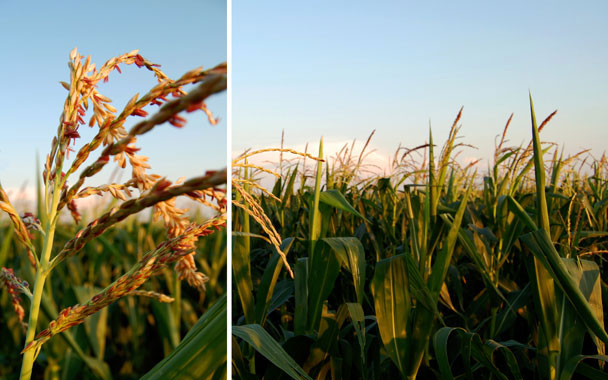The dog days are hot and humid on the Great Plains. Our farmers continue to sleep with one eye open to the nightmare rumble of late-night thunderstorms. On July 24, the National Weather Service recorded six inches of rain and flash floods in Hutchinson County. On the 25th, 70-mile-an-hour winds and hail bigger than golf balls pelted Grant County, knocking out windows just before sunset. In Perkins County, one farmer lost 4,000 acres of wheat to a hailstorm. He reported deer and antelope staggering around in the fields with broken legs, waiting to die.
On the 27th, a few miles east of Dale Hargens’s farm, winds spiked at 65 miles an hour, and hail the size of baseballs took out more wheat and corn. Hargens has been playing a game of hit-and miss with hail all summer. Just last week he lost a third of one wheat field.
Two years ago, Hargens and his daughter-partner, Andrea, took the profits from rising corn and wheat prices and spent close to $300,000 on a new combine and heads. The machinery has to stay busy to pay for itself, so they will spend the next two weeks harvesting winter wheat. They’ll start with neighbors’ fields (for the cost of what an itinerant “contract” crew would charge), and finish with their own, including the field shredded by hail last week. “We’ll have to cut it shorter to get the broken and blown-over wheat,” Hargens explains, “so we’ll have to go a lot slower. But we’ll be able to salvage most of the field.”
Charlie Johnson reflects on Hargens’ fate. “If it’s a drought or a big blizzard, you feel like everyone is in it together, but when you get hailed on, you feel like a lonesome soldier.”
All across eastern South Dakota, tassels lined with dozens of microscopic red flowers dance on the tops of dark green corn stalks, dripping pollen onto the silky threads of future cobs. But when the wind roars, stalks are bent sideways to the ground and pollen sweeps across whole counties. It’s hard to imagine how the patents on genetically modified seeds can be enforced during thunderstorms on the Great Plains. And it’s hard to imagine how Charlie Johnson can protect his organic corn from being pollinated by Monsanto hybrids growing on neighbors’ farms just a quarter mile away. “If I had a bull that kept crashing fences and getting into the neighbor’s cows, I’d have trouble with my neighbor. But no one seems to care about pollen drift,” Johnson says. “I don’t think there’s any pure organic corn anymore, no matter how hard we try, because we can’t control the drift.”
Johnson spent the week hand-cutting weeds in his soybean fields. It has been so wet that his hay-baling operation has ground to a halt, and next week he and his brother will have to do a lot of juggling to get everything done. He will weed in the morning, cut hay in the afternoon, and sometime in between he will try to harvest oats. Temperatures are expected to reach into the 90s next week, rough on corn tassels. He has long, very long, days ahead.
Jim Lutter is ready to harvest the seeds from his intermediate wheatgrass. “Last week the pollen was so thick that it hung in the air like smoke. It seemed from a distance like the prairie was on fire,” he says.
All summer, he has been engaged in an existential challenge with a three-year-old purebred buffalo bull, brought from Wind Cave National Park to diversify the genetics of his herd. But Wind Cave is almost 300 miles west of Lutter’s ranch, and several times in early summer the bull would simply walk through the fence and head west to Wind Cave, sometimes taking a small herd of cows and other bulls with him. It got downright frustrating for Lutter; chasing the bull around the countryside has been a huge waste of time. But the herd cows went into oestrus in mid-July, and the bull has stayed close to home ever since. A reckoning will come this fall. If the bull heads west, Lutter impatiently proclaims that he will fill the freezer with meat.
Wheatgrass and genetically pure buffalo are gambles, adventures, innovations on the margin of the industrial-farm economy, but the foundation of Lutter’s income is aerial spraying. This week he will begin to spray sunflowers, the dark-horse commodity of the plains. Sunflowers are planted late, after the corn, wheat, and soybeans are in the ground. They inconspicuously bide their time, and then one morning in late July they are five feet tall.


